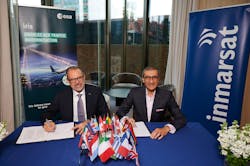ESA contracts Inmarsat to help with airspace congestion and uncrewed integration
PARIS - The congestion of airspace around the world is increasing rapidly, and pressure is mounting on the aviation industry to seek more sustainable practices. In Europe alone, skies are expected to see a 50% increase in flights in the next 20 years – while recent estimates anticipate 40 times more commercial UAVs will be flying beyond visual line-of-sight by 2030 than commercial aircraft.
Inmarsat and the European Space Agency (ESA) have signed a new contract focusing on the globalization of their Iris air traffic modernization program.
This new phase, Iris Global, will focus on the technologies and certification required to share the fuel, CO2, and congestion-saving benefits of Iris with regions far beyond Europe. To further accelerate ATM modernization, it will also adopt System Wide Information Management (SWIM) applications to facilitate greater sharing of information such as airport operational status, weather information, flight data, and status of any airspace restrictions. In addition, research on future capabilities for the integration of uncrewed aviation into European airspace will be supported.
Iris, developed in a public-private partnership launched by ESA, is a service operating on Inmarsat’s SB-S platform. It was created to deliver powerful benefits to airlines and Air Navigation Service Providers (ANSPs) by enabling high bandwidth and cost-effective satellite-based datalink communications between air traffic controllers and pilots.
Entering commercial and operational service in Europe in 2023, Iris will be the first communication service benefiting from a Pan-European certification from EASA, the European aviation safety agency. It allows aircraft to send and receive live data with ground systems during the entire flight, enabling increased predictability of operations and the ability to adapt to evolving conditions on the air traffic network, thus making Air Traffic Management (ATM) more effective and safer.
Iris will be an enabler for trajectory-based operations to be implemented through the sharing of four dimensional (4D) trajectory data between the aircraft and the ground. Initial 4D trajectories will enable optimized climb and descent pathways – but also allow for en route optimization of the trajectory, creating fuel and CO2 emissions savings. Iris makes use of the International Civil Aviation Organization’s (ICAO) Aeronautical Telecommunication Network (ATN) standards, including those suitable for future ATM and ATN Open Systems Interconnect (ATN OSI) protocols, enabling ground-breaking new ATM functionalities such as 4D trajectory management to be deployed.
For the fully global Iris solution, Inmarsat will work with industry partners and standards organizations to also implement next-generation ATN/IPS (Aeronautical Telecommunication Network using Internet Protocol Suite) satellite communications, which are currently being finalized as the global standard for air traffic control communications to and from the aircraft. Iris Global will build a seamless ATN/OSI to ATN/IPS gateway, allowing all aircraft, no matter which of the two standards they operate on, to fly seamlessly across the globe.
